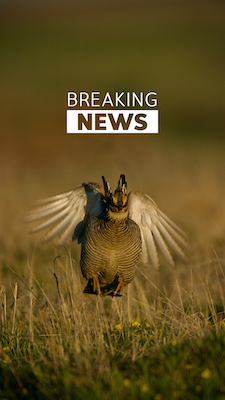 Today, United States Department of Agriculture (USDA) Undersecretary Robert Bonnie announced the Natural Resources Conservation Service (NRCS) would invest $500 million in Working Lands for Wildlife initiatives over the next five years. The historic investment will ramp up conservation assistance for farmers, ranchers, private forest owners and tribes within key geographies and species while leveraging the Conservation Reserve Program.
Today, United States Department of Agriculture (USDA) Undersecretary Robert Bonnie announced the Natural Resources Conservation Service (NRCS) would invest $500 million in Working Lands for Wildlife initiatives over the next five years. The historic investment will ramp up conservation assistance for farmers, ranchers, private forest owners and tribes within key geographies and species while leveraging the Conservation Reserve Program.
“What an incredible commitment to wildlife at a meaningful scale,” said Ron Leathers, Pheasants Forever and Quail Forever’s chief conservation officer. “This investment has a chance to reverse population decline in some of our most threatened upland and grassland species, including the bobwhite quail, sage grouse, and lesser prairie chicken. Likewise, numerous other game and non-game species will benefit greatly from this announcement, in addition to improved water quality and soil health. Thank you to USDA and its leaders for their dedication to working lands, producers, wildlife, and America’s rural communities.”
The announcement puts wheels in motion to update existing Frameworks for Conservation Action in the Northern Bobwhite, Grasslands and Savannas, the Sagebrush Biome, and the Great Plains Grasslands Biome to newly integrate the Farm Service Agency’s Conservation Reserve Program. USDA will also work with partners to develop four new frameworks to be released in 2024-25:
Western Migratory Big Game: A strategy to maintain large and connected working lands in the West to help sustain some of our nation’s iconic wildlife migrations.
Eastern Deciduous Forest: A strategy to achieve forest health and habitat restoration that benefits declining wildlife dependent on young forests.
Eastern Aquatic Connectivity: A strategy to guide restoration of rivers and wetlands to support habitat connectivity in watersheds with significant at-risk species.
Southeastern Pine Ecosystems: A strategy to establish and maintain native pines with cultural, ecological, and economic value.
“When you find a conservation approach that works, double down—and that’s what we’re doing with Working Lands for Wildlife,” said Robert Bonnie, USDA’s Under Secretary for Farm Production and Conservation, who briefed state leaders today at the Western Governors Association meeting in Boulder, Colorado. “America’s farmers, ranchers, forest owners and tribes steward the majority of our nation’s wildlife habitat, and our work with them has yielded enormous gains for sage grouse, longleaf pine, and other species and ecosystems. Working Lands for Wildlife is ready to go to the next level, and today’s incorporation of the Conservation Reserve Program into its vision is a major leap forward. We pledge to keep building the policy, funding, and human capacity to deliver large-scale, working-lands conservation well into the future.”
Pheasants Forever and Quail Forever recognize the enormous impacts these investments will have for grassland species such as pheasants, quail, sage grouse, lesser prairie chickens, monarch butterflies, and native bees – all declining species with direct ties to grassland loss. The organization views Working Lands for Wildlife as the premier approach to habitat conservation efforts benefiting people and wildlife for the future.
In a shared partnership with USDA and many other national, state and local partners, Pheasants Forever and Quail Forever feature one of the largest private lands biologist workforces in America to assist landowners with implementation of voluntary conservation programs. To learn more about the financial and environmental benefits of Working Lands for Wildlife, visit your nearest USDA Service Center or contact a Pheasants Forever or Quail Forever biologist for enrollment opportunities.
About Pheasants Forever
Pheasants Forever and Quail Forever make up the nation's largest nonprofit organization dedicated to upland habitat conservation. This community of more than 400,000 members, supporters and partners is dedicated to the protection of our uplands through habitat improvement, public access, education and advocacy. A network of 754 local chapters spread across North America determine how 100 percent of their locally raised funds are spent — the only national conservation organization that operates through this grassroots structure. Since its creation in 1982, the organization has dedicated more than $1 billion to 575,000 habitat projects benefiting 24 million acres.
Media Contact
Jared Wiklund
(651) 209-4953
JWiklund@PheasantsForever.Org